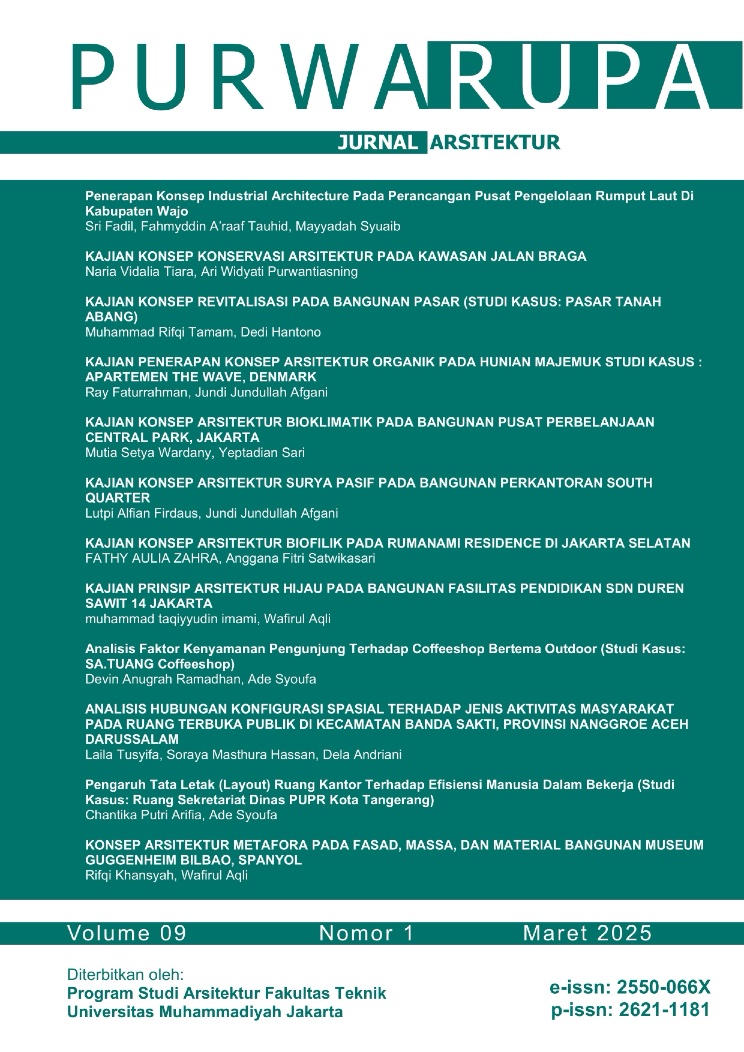KAJIAN PENERAPAN KONSEP ARSITEKTUR ORGANIK PADA HUNIAN MAJEMUK STUDI KASUS : APARTEMEN THE WAVE, DENMARK
Abstract
Kepadatan penduduk merupakan permasalahan yang mempengaruhi kualitas hunian masyarakat. Hunian merupakan tempat tinggal yang menjadi dasar kebutuhan bagi manusia yang memenuhi kebutuhan hidup seperti beristirahat, berteduh, dan bersosialisasi. salah satu strategi untuk menciptakan lingkungan yang baik adalah dengan menggunakan konsep hunian majemuk. Hunian majemuk merupakan hunian yang dikelompokan dan didalamnya terdapat fasilitas pendukung. Salah satu jenis hunian majemuk adalah apartemen. Apartemen sebagai hunian perlu menciptakan kenyamanan. Konsep arsitektur organik merupakan strategi yang baik dalam menciptakan kenyamanan dengan cara memperhatikan keharmonisan lingkungan alam pada hunian. Metode penelitian yang digunakan pada penelitian ini adalah metode kualitatif dengan cara domukentasi dan observasi. Tujuan dari penelitian ini adalah untuk mengkaji bagaimana penerapan konsep arsitektur organik pada objek studi apartemen yaitu The Wave, dengan menggunakan 8 prinsip arsitektur organik menurut Frank Lloyd Wright. Hasil penelitian ini menunjukan bahwa apartemen The Wave sudah menerapkan 8 prinsip menurut Frank Lloyd Wright yaitu bangunan terinspirasi dari alam, mengikuti perkembangan zaman, pemanfaatan energi, sesuai kebutuhan, adaptasi lingkungan, material alami, berciri khas, dan memiliki irama. Kata Kunci: Kepadatan penduduk, Hunian, Hunian Majemuk, Metode Kualitatif, Arsitektur organik ABSTRACT. Population density is a problem that affects the quality of community housing. Housing is a place to live that is a basic need for humans who meet life needs such as resting, shelter, and socialising. one strategy to create a good environment is to use the concept of compound housing. Multiple dwellings are grouped dwellings in which there are supporting facilities. One type of compound housing is an apartment. Apartment as a residence needs to create comfort. The concept of organic architecture is a good strategy in creating comfort by paying attention to the harmony of the natural environment in housing. The research method used in this research is a qualitative method by means of documentation and observation. The purpose of this research is to examine how the application of the concept of organic architecture in the apartment study object, The Wave, using 8 principles of organic architecture according to Frank Lloyd Wright. The results of this study show that The Wave apartment has applied 8 principles according to Frank Lloyd Wright, namely Buiding as nature, Continous Present, Form follows flow, of The People, of the hill, Of the material, Youtgful and unespected, dan living music. Keywords: Population density, Residential, Multiple occupancy, Qualitative method, Organic architectureReferences
Rasikha, Tezza. 2009. Arsitektur Organik Kontemporer. Depok: Universitas Indonesia.
Wati, Gina (2022). Kajian Konsep Arsitektur Organik Pada Kawasan Agrowisata Modern The Ranch, 7(2), 170-183.
Sonny Keraf (2019). Filsafat Lingkungan Hidup: Alam Sebagai Sistem Kehidupan. PT Kanisius
Marina Zbasnik-Senegachik & Manja Kitek Kuzman (2014). Interpretation Of Organic Architecture. Diperoleh dari researchgate.net
Widati, Titiani (2015). Rumah Usonian sebagai Penerapan Arsitektur Organik Frank Lloyd Wright, 9(2), 1-9
Rukayah, Siti (2003). Penekanan Desain Arsitektur Organik dan Green Architecture Pada Perancangan Pusat Rekreasi dan Klub Pemancingan Di Rawapeking, Kabupaten Semarang
Aghniya, Mochammad (2021). Kajian Konsep Arsitektur Organik Pada Bangunan South Australian Health And Medical Research Institude/Woods Bagot, 1-8
Downloads
Published
How to Cite
Issue
Section
License
COPYRIGHT POLICY
The author(s) of an article published in the Jurnal Teknologi retains ownership of the intellectual property rights in work (s).
PUBLISHING RIGHTS
The author(s) of an article published in the Jurnal Teknologi have unrestricted publication rights. The authors give the Jurnal Teknologi the right to publish the article and designate the Faculty of Engineering Universitas Muhammadiyah Jakarta Publishing as the original publisher of the article.
LICENSING POLICY
Journal of Mechanical Engineering and Sciences is an open-access journal that follows the Creative Commons Non-Commercial 4.0 International License (CC BY-NC 4.0), which states that:

Under this license, the reusers must give appropriate credit, provide a link to the license, and indicate if changes were made. Users may do so in any reasonable manner, but not in any way that suggests the licensor endorses users or their use.
Please take the time to read the whole license agreement (https://creativecommons.org/licenses/by-nc/4.0/). As long as reusers follow the license conditions, the owner cannot withdraw these freedoms. The following components are included under this license:
 Attribution: Users must provide appropriate attribution, including a link to the license, and indicate whether or not they made any modifications. Users are free to do so reasonably, but not in a manner that indicates the licensee approves of their usage.
Attribution: Users must provide appropriate attribution, including a link to the license, and indicate whether or not they made any modifications. Users are free to do so reasonably, but not in a manner that indicates the licensee approves of their usage.
 NonCommercial: Users may not use the material for commercial purposes.
NonCommercial: Users may not use the material for commercial purposes.

